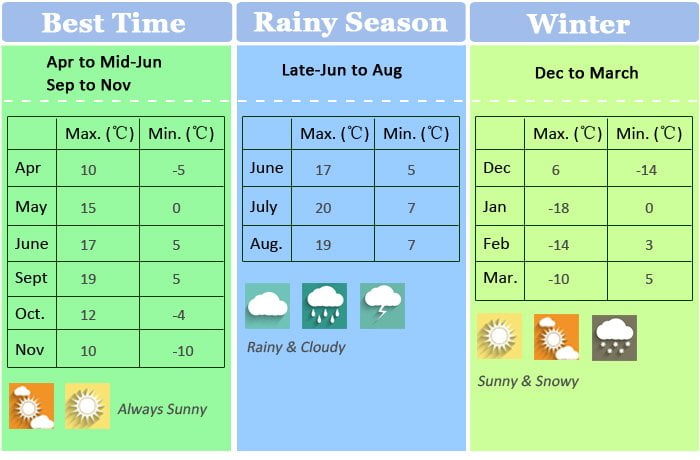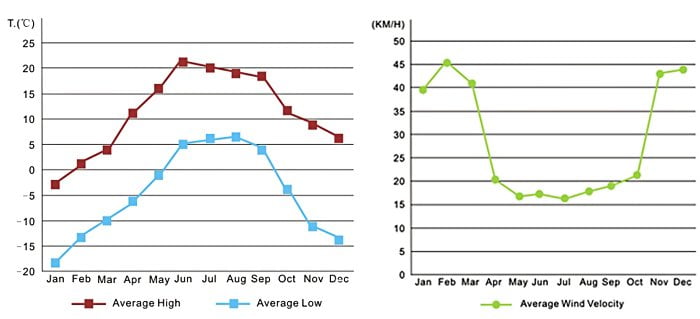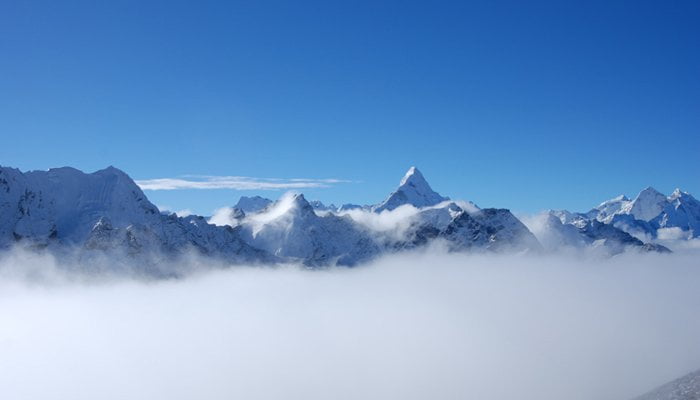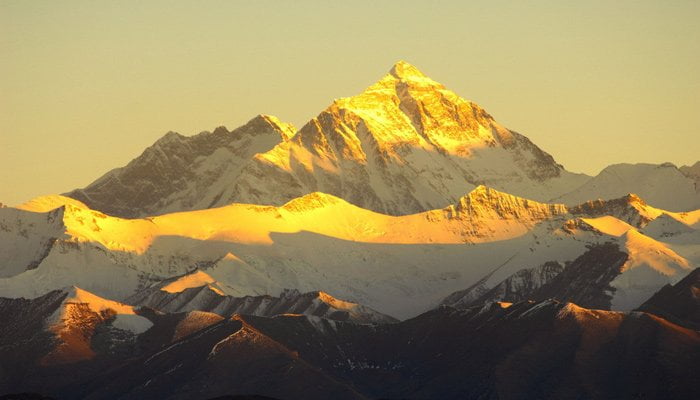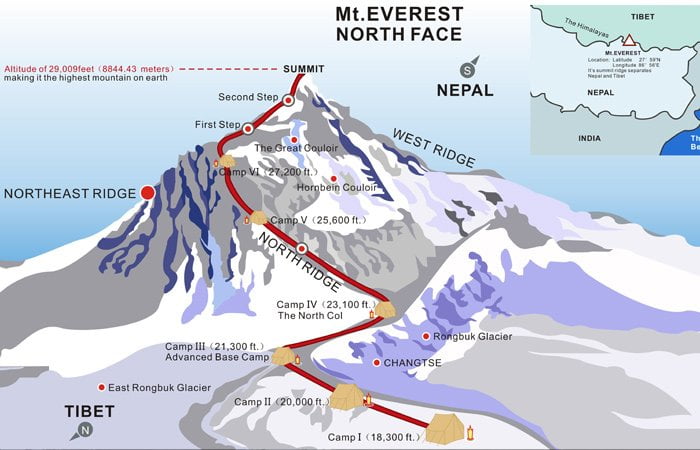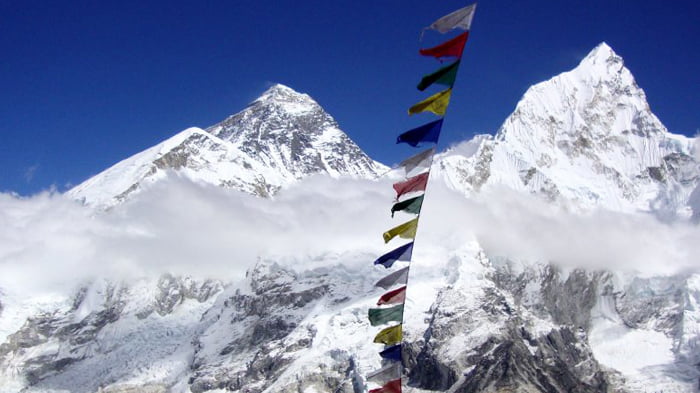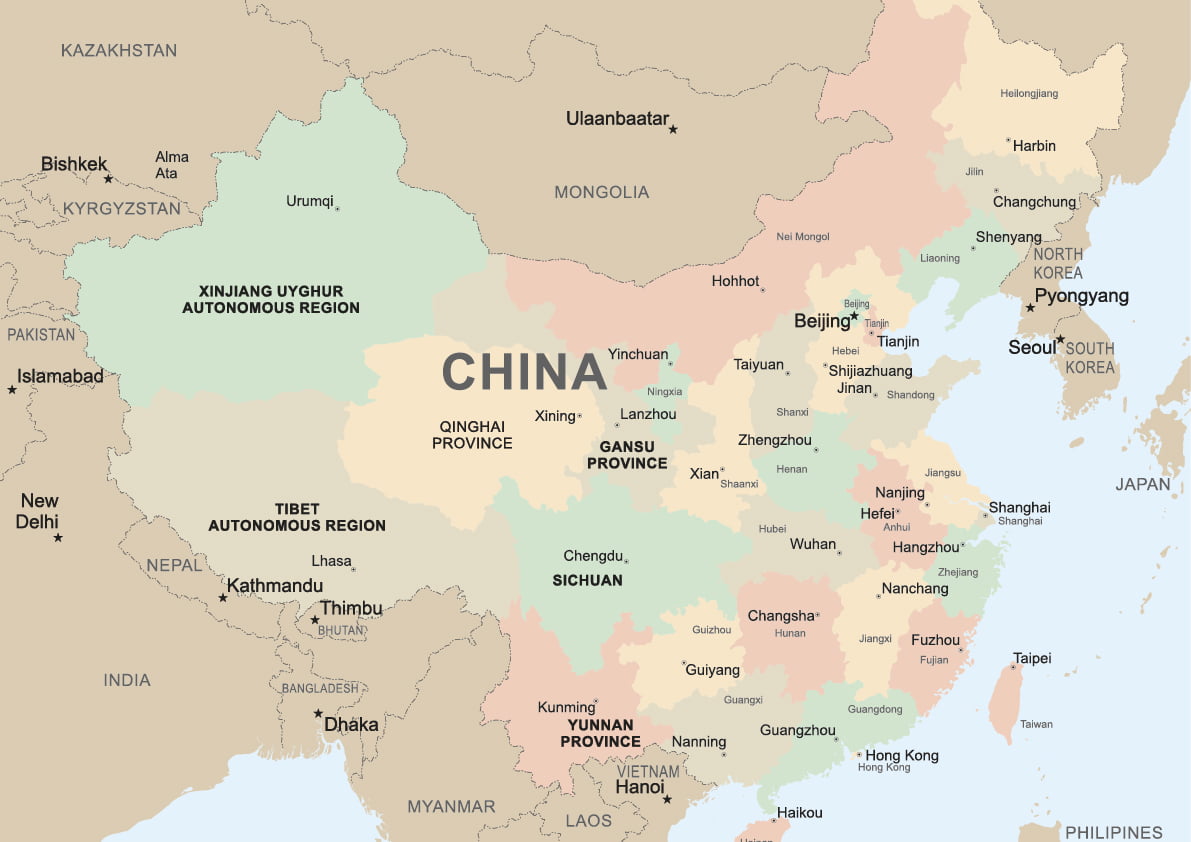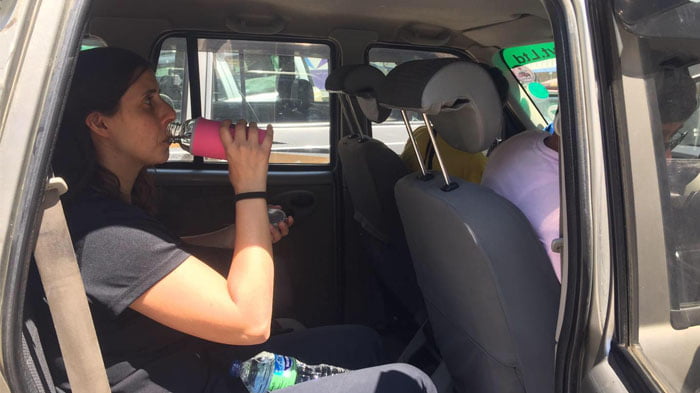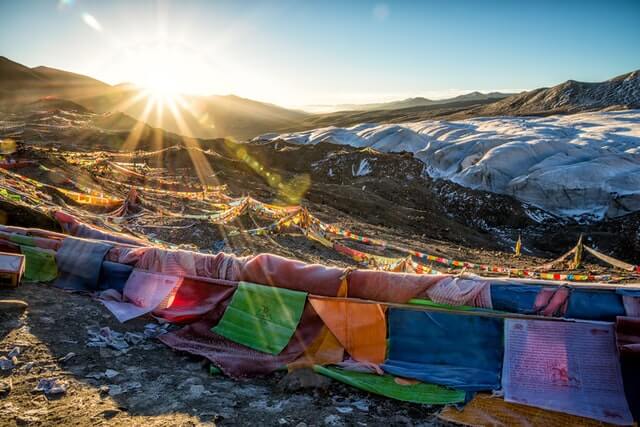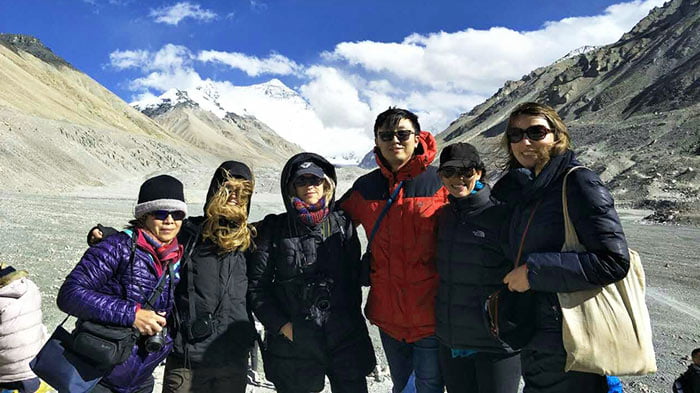The most recommended time for touring the Mount Everest falls from April to June and September to November.
The two periods of the recommended time for Tibet EBC tour bears a lot of similarities. From April to June, the temperature rises moderately and the weather turns to be much warmer. Days start to stretch out to provide more daylights for visitors to explore while the night tends not to be as cold as in winter time.
Down the trail in the valley, flowers are in early bloom and plants and trees are all turning green. The grassland becomes luxuriant everywhere with strong vitalities. This period of time is widely accepted as not only the best time for Everest Base Camp tour but for the Mount climbing as well.
With the receding of the yearly monsoon reason in September, October and November, days are gradually dominated by the constant bright sunshine with warm temperature and comfortable fresh air.
Wind blows away the thick covering clouds and the Everest mountain peak is brought to light again. With great visibility, a variety of trees and plants start turning yellow or red, making the EBC trail the multicolored one with the most stunning views among all the seasons.
A climate picture to help you decide when to visit Everest Base Camp
Detailed Temperatures, Rainfall Information in These Months:
April—Max. Temperature: 10°C; Min. Temperature: -5°C; Rainfall: 8 mm
May — Max. Temperature: 15°C; Min. Temperature: 0°C; Rainfall: 8 mm
June — Max. Temperature: 17°C; Min. Temperature: 5°C; Rainfall: 31 mm
September — Max. Temperature: 19°C; Min. Temperature: 5°C; Rainfall: 39mm
October — Max. Temperature: 12°C; Min. Temperature: 4°C; Rainfall: 18 mm
November— Max. Temperature: 10°C; Min. Temperature: -10°C; Rainfall: 1 mm
Tour Everest Base Camp during Tibetan monsoon season from July to August.
In summer time from July to August, the monsoon season comes. Rain falls constantly during these two months. At the same time, the temperature rises and maintains at the highest level of the entire year. So the weather tends to be moderate with the perfect humidity. July and August are also the peak season of the year to receive worldwide visitors.
Detailed Temperatures, Rainfall Information in the two months:
July— Max. Temperature: 16°C; Min. Temperature: 8°C; Rainfall: 94 mm
Precipitation increases to the highest level of the entire year. Constant rainfalls make you care more about the rainproof gears when preparing in advance.
August— Max. Temperature: 16°C; Min. Temperature: 6°C; Rainfall: 108 mm
One of the worrying things that baffles you must be the weather during monsoon season. Well, to tell the truth, you definitely encounter rains during the season no mater you arrive in Tibet in early, middle or late of each of these months.
However, the summer rain is not as horrible as you have imagined. It’s not the continuous heavy rain or the non-stop and intense rainstorm, rather, it is just a short spurts of rain or a slashing rain that lasts a short period of time at night or in the afternoon.
Meanwhile, after the intermittent rain there always follows the sunshine. The sunshine becomes much brighter, and sometimes with rainbow across the blue sky. The thin cloud shrouded mountain peak adds more mysteries to every place of the sacred Mount Everest, turning to be another fantastic panorama view to document.
Moreover, if you are exposed to the sunshine, you may find it quite fierce and easy make your skin get burnt. But once you enter the room or stay in the shade, a sense of cool sweeps all over your body immediately, effectively keeping you from the summer heat.
Everest is easily covered by mist and cloud in rainy season.
Tour Everest Base Camp in winter: December, January and February
In winter, the temperature drops fast, sometimes accompanied with hollowing wind and heavy snow. Nevertheless, winter Everest Base Camp is eminent for its clear deep blue sky in the daytime and the star-studded milky way at night.
Detailed Temperatures, Rainfall Information in these months:
December— Max. Temperature: 4°C; Min. Temperature: -15°C; Rainfall: 2 mm
January— Max. Temperature: 4°C; Min. Temperature: -17°C; Rainfall: 6 mm
February— Max. Temperature: 4°C; Min. Temperature: -15°C; Rainfall: 4 mm
March— Max. Temperature: 7°C; Min. Temperature: -12°C; Rainfall: 4 mm
With no dense or even the shrouded clouds, Mount Everest unveils its iconic mountain peak unreservedly with golden sunrise and sunset glow painted on it, making the entire mountain peak much more magnificent than most of the days during the peak tourist season.
Besides, with less precipitation, the possibility for tourists to be enchanted by the canopy of the heaven dotted with shimmering stars has, to a great extent, increased. The mysteriously colored Milky Way lies silently in the sky, revealing the magnificence in all its splendor, making constant tranquility in every visitor’s heart. Much clearer and brighter stars are around you, seeming like you have stumbled into the boundless universe.
Beautiful Sunrise of Everest in Winter Photoed by Ben, one of our clients
- Winter tends to be a good time to tour EBC, for the clear sky and the constant sunshine. But the temperature tends to be a bit low, especially at night. Put on more clothes and pay attention to keep warm.
- Guesthouse in Rongbuk Monastery is the only place that all visitors can stay overnight near the Everest Base Camp in chilly winter. (Approximately 8 km away from EBC)
- With much better visibility, Garula Pass which accepted as world’s best site to get a panorama view of the Himalaya Mountains on the way from Tingri County to the Everest Base Camp turns into another scene. The cloudless sky becomes deep blue, with the picture scroll of snow-capped Himalaya Mountains presenting clearly in front of your eyes.
- Identifications for visitors to take an Everest Base Camp tour.
- In March, the temperature begins to increase but the whole Tibetan is due to be closed until April 1.
6. Winter Everest Base Camp tour is thrilling and full of possibilities to explore more exciting things that are rarely-seen during other seasons. - Besides the Everest Base Camp, a great number of other interesting things relating to the natural resort and cultural custom you can find in some warmer cities like Lhasa, Shigatse and Nyingchi in winter. (Click here for winter Tibet tour)
When is the Best Time for Trekking Everest Base Camp in Tibet?
Typically, there are mainly two routes in Tibet for the trekking to the Everest Base Camp. The following two Everest Base Camp trekking routes are favored most by our clients.
One route, also the preliminary trekking route is the old Tingri to Everest Base Camp Trek. And apparently, trekking from old Tingri to the Everest Base Camp can be much more thrilling than arriving at there just by taking the tourist buses.
The other route, which is also regarded as more competitive and challenging one, is the Everest Base Camp to Advanced Base Camp trekking, which can provide you with the unparalleled experiences to trek so close to the Mount Everest.
What is the Best Time for Tingri to Mount Everest Base Camp trekking?
The best time to trek from Tingri to the Everest Base Camp is from April to June and September to October. The temperature maintains at a comfortable level with less rainfall but much more sunshine. Mellows are turning green and sheep and goats can be seen grazing land grass everywhere.
If you have no alternative time during these months, you can also take July and August into consideration. The summer rain masses the trekking trail a little bit, but it never slows down your forward steps, for the rain doesn’t last for a long time.
What’s the best time of a year to trek from EBC to ABC?
As the world’s highest Tibet trekking route, the best months for trekking to the advanced base camp are in April, May, September and October. Make full use of the small window of opportunity available to climb the Mount Everest before and after the monsoon season.
Before and after the monsoon season, days are mainly sunny with less rainfall and perfect visibility. Glaciers, ridges, pinnacles are seemingly near at hand. Along the trekking route, every piece of view is magnificent, and what you need to do is just adjust your breath and stepping forward.
Highlights of this Trekking:
1. Rongbuk Glacier: The largest glacier among the hundreds of glaciers formed around the Mount Everest
2. Icy pinnacles and hanging ice surrounded in all directions
3. Solemn mountains with mist shrouded mountain ridges
4. Snow-capped Everest Peak
When is the Best Time to Climb the Mount Everest?
(April to May; September to November)
Many experienced mountaineers choose to climb the Mt. Everest from the north side as it is more challenging than the south side. Tibet EBC is located at an altitude of 5,200 meters (17,056 ft) and is used when climbing via the northeast ridge. The North Base Camp has vehicle access (at least in the summer months) through a 100km road branching to the South from the Friendship Highway near Shegar. So the worldwide climbers and mountaineers can choose to arrive at the North Base Camp by bus.
Typically, climbers rest at base camp for several days for acclimatization to reduce the risks and severity of altitude sickness. In fact, the “tourists Base Camp” is located about half-way between Rongbuk Monastery and the actual climbers Base Camp at the foot of Rongbuk glacier.
The best time for mountaineers to climb the Mt.Everest is from April to May and from September to November, which are also the most ideal periods to visit the Mount Everest Base Camp.
A guide map showing the hiking route of Mount Everest in Tibet side.
When is the Best Time to Tour/Trek Everest Base Camp in Nepal Side?
The Mount Everest is located at the border between Nepal and Tibet. Its northern part is located in Tingri County in southwestern Tibet. There are two Everest base camps on opposite sides of Mount Everest, namely South Everest Base Camp in Nepal and North Everest Base Camp in Tibet. The best place to view the Mt. Everest is at the EBC in Tibet. At the Everest Base Camp in Tibet, travelers can see the magnificent northern face of this highest peak on the earth.
Everest view in Nepal Side
Both of the Everest Base Camps are on the same mountain and share quite some similarities for the best time to travel. For the Everest Base Camp in Nepal side, the best time of a year to trek are in September, October and November.
September: Max temperature: 18°C (64.4 °F); Min temperature: -5 °C (23 °F)
October: Max temperature: 16 °C (60.8 °F); Min temperature: -5°C (23 °F)
November: Max temperature: 7 °C (44.6 °F); Min temperature: -15°C (5 °F)
With perfect temperature and less precipitation, Everest Base Camp in Nepal side enters its best time for trekking. Sky turns to be much clearer with little clouds but bright sunshine. Temperature maintains at a comfortable level. Swarms of visitors can be found on the beaten track, making the Everest Base Camp one of the most popular spots to tour.
From mid-November, temperature begins to fall dramatically with gradually dry air and less rainfalls, Everest Base Camp is becoming calm with tranquil beauty. More thick clothes are needed if you want to stay overnight on the Everest Base Camp.
Overall, Kathmandu with agreeable weather is perfect for travel in all seasons. For trekkers, the best season to do trekking in Everest Region is around from Oct to Nov.
Conclusion
Sceneries of Everest Base Camp and along the way vary from April to next Feb, so you can take the Everest Base Camp tour any time you like during this period of time in the year to experience the changing views.
From April to June, the temperature rises moderately and the weather turns to be much warmer. Days start to stretch out to provide more daylights for visitors to explore. Flowers are in early bloom and plants and trees are all turning green, making the perfect time for touring the Everest Base Camp.
From September to November, the receding of the yearly monsoon reason makes the Everest Base Camp as well as the entire Tibet dominated with continuous sunshine and perfect visibility, colorful views can be framed on the trail to EBC during these two months.
During Tibetan monsoon season from July to August, rain falls constantly during these two months. At the same time, the temperature rises and maintains at the highest level of the entire year. So the weather tends to be moderate with perfect humidity. You don’t have to worry too much about the monsoon rain, for it is just the spurts of rain that lasts a short period of time.
From December to February, the temperature drops fast, sometimes accompanied with hollowing wind. Nevertheless, winter Everest Base Camp is eminent for its clear deep blue sky in the daytime and the star-studded milky way at night.
For Everest Base Camp trek in Tibet, the best time are April, May, September and October.
The best time to climb the Mt. Everest is during the well-known spring window and autumn window periods from April to May and September to November.
The best time for Everest Base Camp trekking in Nepal side are around September, October and November.
If you have any other questions, please don’t hesitate to consult our friendly guide or feel free to drop us a line.

